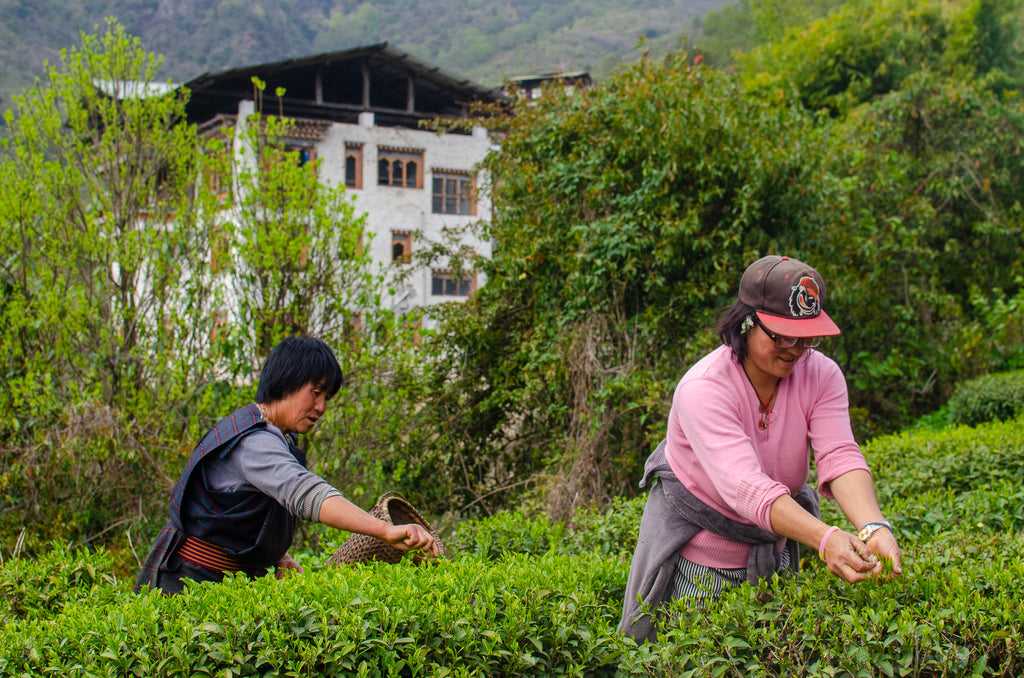We’re Back in Bhutan

One of the most rewarding projects we’ve been involved with recently, in cooperation with Bhutan’s Ministry of Agriculture, is the establishment of a tea garden in a country with no history of production. In our previous blog post, you can read all about the history of the project, which stretches back to the 1990s: This was when I first found a plot of tea bushes growing outside the royal family’s former winter palace, brought over decades earlier from Darjeeling and since forgotten. The result is our Thunder Dragon Green tea—a unique combination of Chinese seed, Bhutanese terroir, and Korean processing techniques.
We’re especially excited about the new 2019 lot, not only because it’s from the very first day of harvest, but also because we were at the farming cooperative during its production this April. I’ve been fortunate to visit the farm countless times over the years, witnessing the evolution of this beautiful tea; this time, I brought along some tea friends to observe and help refine the process.

The crew included IPOT partner Ana Dane; Kevin Gascoyne, a co-owner of Montreal’s Camellia Sinensis; and Bachan Gyawali, the co-founder of Nepal’s Jun Chiyabari tea garden, which produces our Himalayan Black and Himalayan White teas. Over several days we met with different members of the cooperative, as well as agriculture ministry officials and former agriculture secretary Dasho Sherub Gyaltshen, to discuss how the farmers can best expand on their successful work.
Each of the cooperative’s 26 individually owned tea plots sits at almost 6,000 feet elevation, a comparable altitude to the Darjeeling estates where the original tea bushes were brought from. The environment is ideal for Camellia sinensis, with steep hills that allow for good drainage; cool, humid air; native trees and other shrubs, which offer healthy biodiversity; and fertile, untouched soil. Farmers in this area are disinclined to utilize expensive chemical fertilizers and pesticides, so the land has remained pristine.

The hope is to increase production, but as with tea farmers all over the world, there are challenges, notably with plant maintenance, labor, and processing consistency. This is a common situation in developing agricultural regions: an innovative farmer or collective develops a good product that brings in revenue, but then is faced with obstacles to scale up the business. Sometimes they give up, because the manual work required just becomes overwhelming; other times, shortcuts could be taken that compromise the quality of the product. But for this Thunder Dragon tea, we’re all in it for the long haul. Other farmers in the area have noticed the collective’s success and are interested in joining the group, and the collective is experimenting with different styles of tea to expand their offerings.
At IPOT, we want to support producers like this not only through our purchases, but also by providing any pertinent tools and knowledge. We believe this the best way to help new growers—maintaining the inherent dignity of their work and positioning them as active partners in a collaborative enterprise. By paying good prices for good product, it creates a natural incentive for improvement and sustainable growth.

During this recent trip to Bhutan, we were happy to share the new harvest Thunder Dragon Green with guests at a tasting event with the Amankora hotel in Thimphu. The response was better than we could have hoped for, and now we’re thrilled to share the first few kilograms of this unique tea with you. Snag some before it’s gone!
